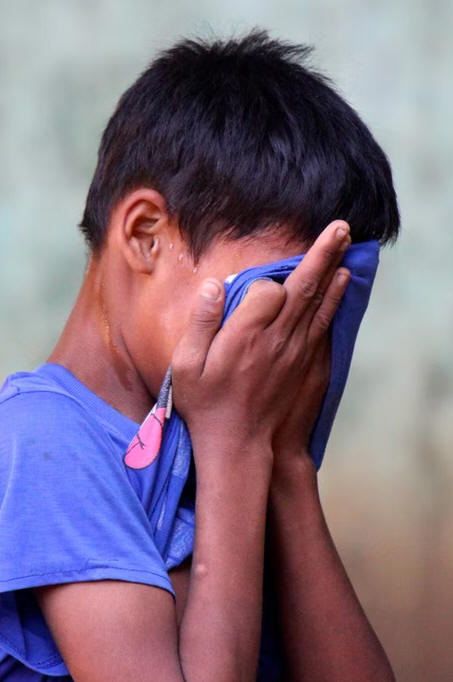The
Effects of Abuse on Children
January 2003, March 2022
 Many are not aware of the long-term, devastating effects abuse can have on a
child. Whether a child experiences abuse directly or witnesses it, the effects
often hinder the physical, intellectual, and emotional growth of the child.
April is Child Abuse Prevention Month in The Bahamas. It is a time to educate
the public on the effects of child abuse, its prevalence in our society, and how
to bring healing to those who are being abused. Many are not aware of the long-term, devastating effects abuse can have on a
child. Whether a child experiences abuse directly or witnesses it, the effects
often hinder the physical, intellectual, and emotional growth of the child.
April is Child Abuse Prevention Month in The Bahamas. It is a time to educate
the public on the effects of child abuse, its prevalence in our society, and how
to bring healing to those who are being abused.
To help you understand the effect of abuse or family violence in any form on
children, here is a brief overview of its effects on children at each stage of
development:
-
INFANTS AND TODDLERS (0 - 2˝ Years )
Developmental Delay . Failure to thrive due to the chaotic, loud, and
harmful environment. Emotional withdrawal and low frustration tolerance. There
are also physical problems.
PRE-SCHOOL (3-6 Years)
Development Delay , Especially in Language Development. The child
may be afraid to speak, afraid of becoming the target of anger. This is due in
part to not being spoken to by adults or experiencing meaningful discussion with
adults.
Low Frustration Tolerance. The child cries easily and often. Her world is
so chaotic she cannot handle ordinary stress. He usually has not witnessed
appropriate ways of dealing with stress.
Acting Out Aggressively Toward Peers and Adults. She models the
aggressive behavior observed in the home.
Inability to Play Constructively. Lots of throwing or kicking. Possible
destruction of playthings. Many children have not been shown how to play.
Children are working out their frustration and worry in play.
Inconsistent or Inappropriate Display of Emotions. Abuse can result in
the child not learning appropriate emotional responses, as well as not being in
touch with true feelings.
-
SCHOOL AGE (7-11 Years)
- Scholastically Delayed/Poor School Performance.
The child finds studying
and learning difficult when he cannot keep from worrying about what happened at
home last night or who is going to get hurt, or maybe killed later tonight.
Behavior Problems with Peers and Adults. Because of the lack of
observable appropriate interpersonal relationships, the child has not learned
appropriate ways to interact with others. The child may be crying out for help,
the only way he can still keep the "family secret."
Aggressive Acting Out Becomes More Severe and Purposeful. The child
models the violent behavior witnessed in the home.
Fearful/Nightmares/Night Terrors. The child relives fears in her sleep.
She may be afraid of sleep because of incidents of physical and/or sexual abuse
that occur at night. She may have a history of being wakened by mothers’
screams and fathers’ yelling.
Withdraws/Depressed/Hopeless/Despondent. Life offers little, other
 than
physical and/or emotional pain. Joy is lost. than
physical and/or emotional pain. Joy is lost.
Chronic Physical Complaints. There are headaches and stomachaches. The
child knows no other way to realize or describe emotional distress. The stress
level is too high for the child to cope.
Beginning to Mimic Adult Roles, Generally, girls adopt the role of
victims; boys become aggressive and abusive.
Chronic Low Self-Esteem. The child blames self for the situation at home.
The child’s good feelings about himself have not been nurtured.
-
ADOLESCENCE (12-17 Years)
Depression. There is a loss of hope and joy. The adolescent is full of
sadness.
Signs of Physical Injuries, Maiming, Crippling, Scarring. Too often abuse
leaves long-term or permanent scars on the adolescent.
Aggressive/Delinquency/Running Away. The adolescent realizes not one will
take care of his needs, except himself. Adolescent will use the only coping
skills he has leaned: violence and self-destruction.
Poor School Adjustment. The adolescent is academically and socially
unable to perform
Early Sexual Activity/Marriage.
It is common for adolescents who
experience or witness abuse to engage in early sex or marriage as a means of
escape or acting out.
Alcohol/Drug Experimentation or Use. This is another form of escapism or
self-medication for the pain. The adolescent models the behavior of adults
closest to her.
Death by Suicide or Murder. The adolescent takes his own life to end the
pain, or intervenes to protect the mother. This results in harm or death of the
adolescent or adolescent kills the abuser. Many Bahamian children attempt
suicide each year.
Expansion of Violence Into the Community. Criminal activity sometimes
through gang involvement where the teen finds a surrogate family. Anger and
frustration spill over into the community.
Dear readers, we must speak out about all forms of child abuse. Let us not
robe our children of the joys of childhood.
|